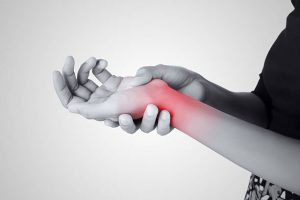
What is De Quervain’s Tenosynovitis?
De Quervain’s tenosynovitis is an idiopathic condition characterized by pain on the radial side of the wrist. It is a common pathology and is described as stenosing tenosynovitis of the tendons within the first dorsal compartment of the wrist. De Quervain’s tenosynovitis has a dramatic effect on individual’s lives physically and psychologically. Physically, it limits the ability to be productive at work, sporting or artistic pursuits and activities of daily living. Psychologically, depression, anxiety and pain catastrophizing have been strongly associated with worse pain and function in individuals with De Quervain’s tenosynovitis.
What causes De Quervain’s Tenosynovitis?
Whilst there is still not a universally known cause to De Quervain’s tenosynovitis, some causes could be explained through blunt trauma, biomechanical compression, forceful repetition of the wrist and thumb leading to increased frictional forces or microtrauma, actions performed, inflammatory diseases, anatomical variations, abnormalities of the first dorsal compartment and rarely, pathogens.
Symptoms of De Quervain’s Tenosynovitis
- Pain at the thumb side of the wrist, aggravated by grasping and pinching activities
- Feeling of catching or crunching under the skin with movement of the thumb
- Reduced thumb movement and swelling over the bony prominence on the thumb side of the wrist
Assessments
- Palpation: tenderness over base of the thumb and/or first dorsal compartment extensor tendons on the thumb side of the wrist particularly over the radial styloid process
- Swelling in the anatomical snuffbox
- Decreased CMC abduction ROM of the first digit
- Palpable thickening of the extensor sheaths of the first dorsal compartment
- Crepitus of the tendons moving from the extensor sheath
- Other possible findings
- Weakness and paraesthesia in the hand
- Finkelstein test: thumb flexed and held inside a first, patient actively clearly deviates the wrist, causes sharp pain along the radial wrist at the first dorsal compartment
Differential diagnosis
- Intersection syndromve
- Osteoarthritis of the first carpometacarpal
- Osteoarthritis of the scaphoid trapezoid-trapezium joint
- Trigger thumb
- Superficial radial nerve neuritis (Wartenberg’s syndrome)
- Fractures of the scaphoid or radial styloid
Treatment and Management
Non-surgical treatment
The aim of non-surgical management is to reduce pain and swelling which include patient education regarding aggravating movements, ice/heat packs, physical therapy and thumb splinting. In cases where the above treatment listed has not been effective, corticosteroid injections have been reported to provide symptom relief.
Surgical treatment
Surgery for De Quervains is rare and usually for individuals when all non-surgical treatment has failed and is consistently experiencing inflammation affecting function. The surgery involves opening the dorsal compartment covering to make more room for irritated tendons and allow pressure relief of the tendons. Ultimately, this restores free tendon gliding.
Physiotherapy management
Splinting
This method has been found extremely effective in decreasing pain while increasing individual’s ability to continue to participate in ADL’s. The splint immobilises the wrist and thumb preventing aggravating movements that commonly lead to the stenosis of the dorsal compartment, facilitating rest and recovery. Traditionally, the splint is recommended for 4-6 weeks, however, there is still limited research on a conclusive timeframe.
Ice/Heat packs
Heat can help relax and loosen tight musculature whilst ice can be used to help relieve inflammation of the extensor sheath
Massage and exercise
Deep tissue massage at the thenar eminence can help relax tight musculature that brings on the pain. Evidence suggests that massaging in conjunction with exercise has been extremely beneficial for individuals with De Quervains tenosynovitis as it promotes breaking down fascia restriction, stretching connective tissue and promoting a better healing environment. Specific points of massage include the hypothenar eminence, adductor pollicis long and extensor pollicis brevis tendon.
Strengthening the muscles have also been found to improve the symptoms of De Quervain’s tenosynovitis. The progression of the exercise therapy starts off as isometric, eccentric, concentric inner range and radial nerve glides. A simple strengthening regime for an individual with De Quervain’s tenosynovitis may include
- Active exercises of the wrist, thumb and tendon gliding exercises for adductor pollicis longus and extensor pollicis brevis for 2 weeks, 2-3 times per day.
- Thumb abductor pollicis longus strengthening
- Isometric thumb extension
- Radial deviation isometric
- Thumb and finger band strengthening
- Wrist flexion with a band
- Radial deviation with a band
References
Allbrook, V. (2019). ‘The side of my wrist hurts’:’De Quervain’s tenosynovitis’. Australian journal of general practice, 48(11), 753-756. Retrieved from https://search.informit.org/doi/epdf/10.3316/informit.728871641057934
Blackburn, J., van der Oest, M. J., Selles, R. W., Chen, N. C., Feitz, R., Vranceanu, A. M., & Porsius, J. T. (2019). Which psychological variables are associated with pain and function before surgery for de quervain’s tenosynovitis? A Cross-sectional study. Clinical orthopaedics and related research, 477(12), 2750. https://doi.org/10.1097/CORR.0000000000000992
Melbourne Hand therapy (2021). De Quervain’s Tenosynovitis. Retreieved from https://www.melbournehandtherapy.com.au/conditions-treated/dequervains-tenosynovitis/
Suresh, T. N., & Kecha, P. (2018). Effect of ultrasound, massage therapy and exercises on de-quervain’s tenosynovitis. International Journal of Yoga, Physiotherapy and Physical Education [Internet], 3(3), 43-8. Retrieved from https://www.researchgate.net/profile/Suresh-T-N/publication/344187368_Impact_Factor_RJIF_524_wwwsportsjournal/links/5f59cdc44585154dbbc40b4a/Impact-Factor-RJIF-524-wwwsportsjournal.pdf
